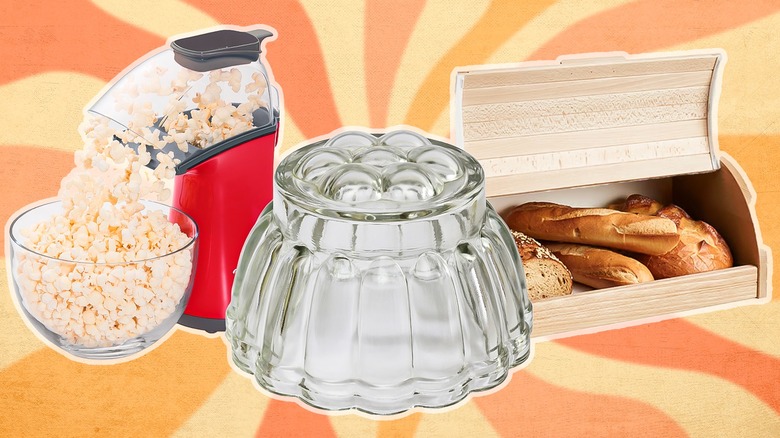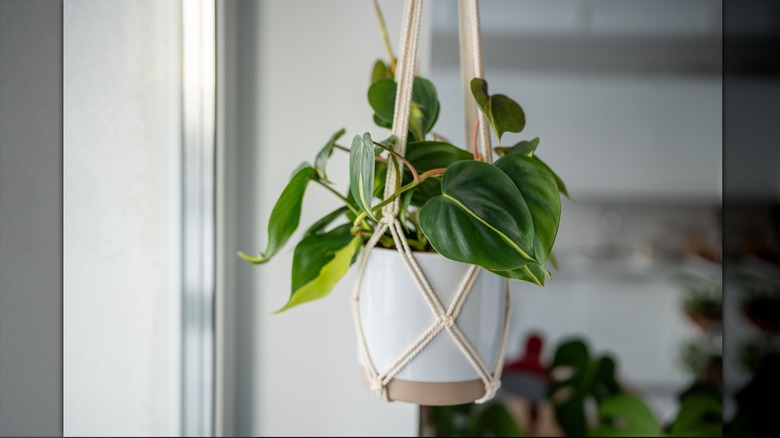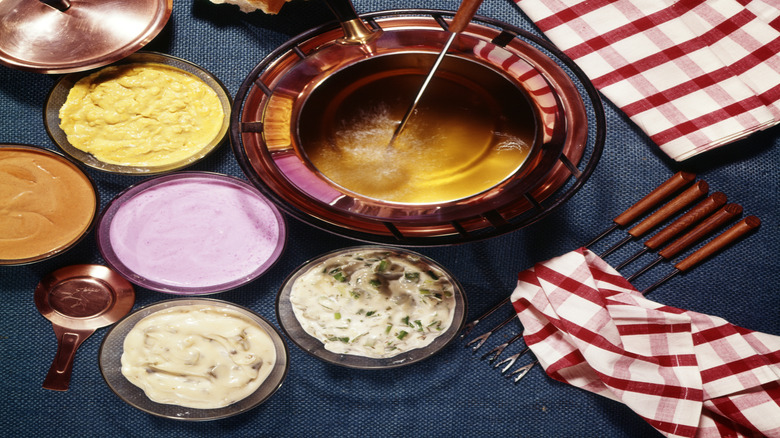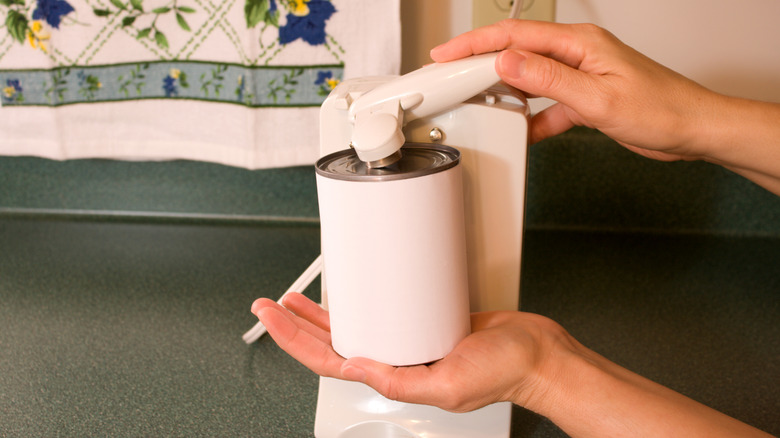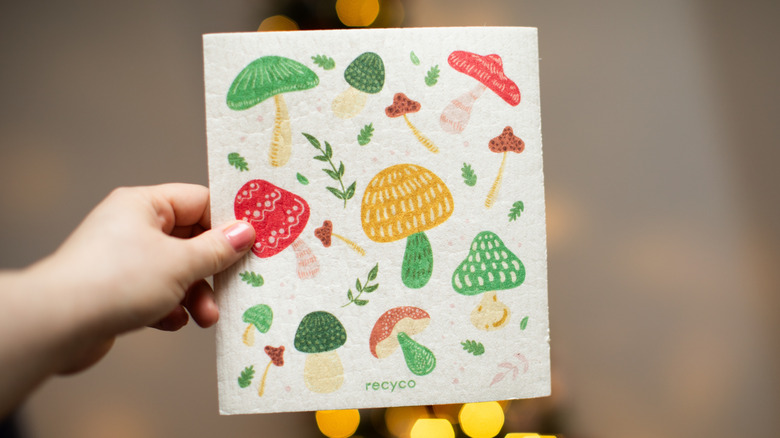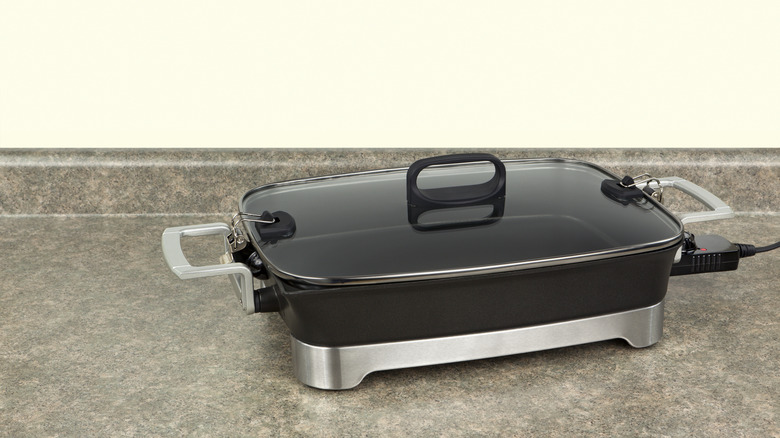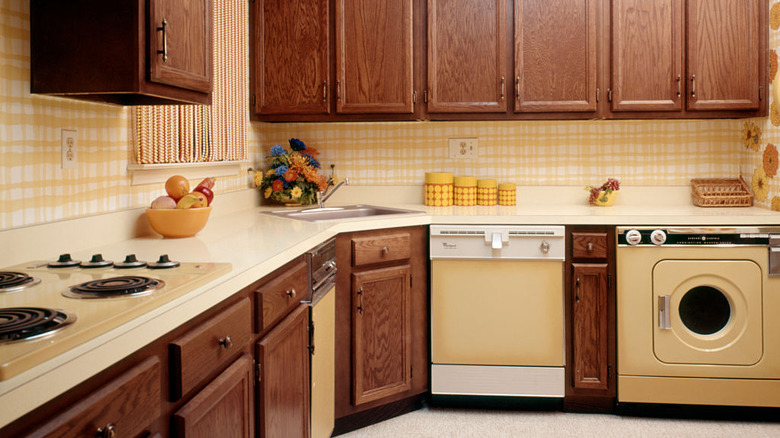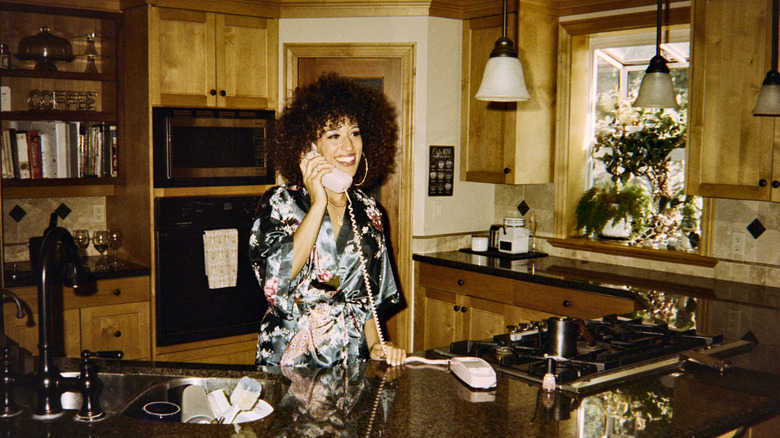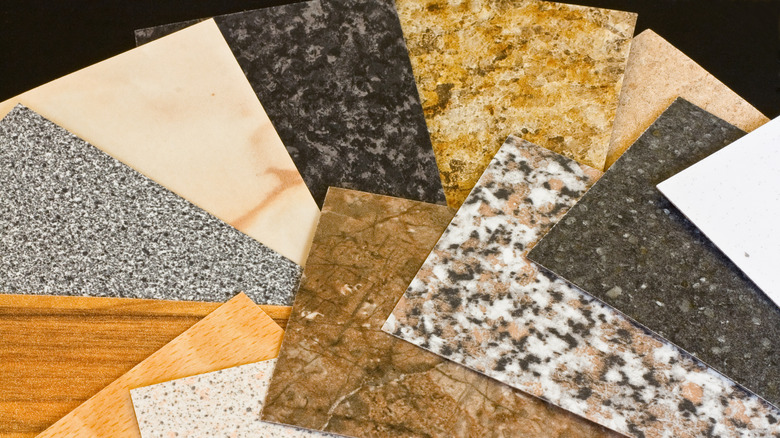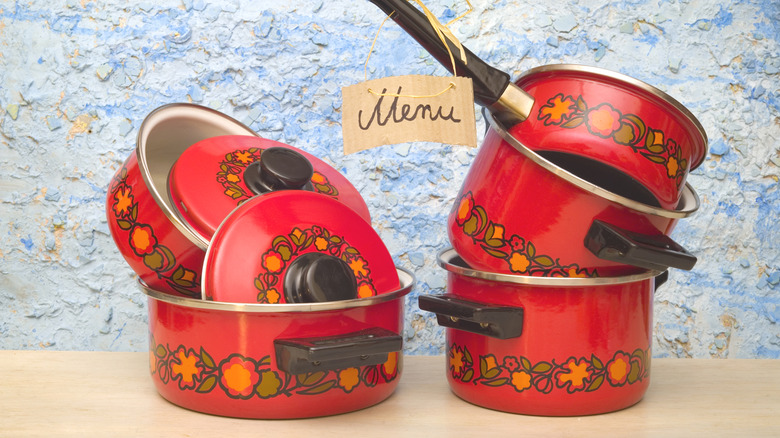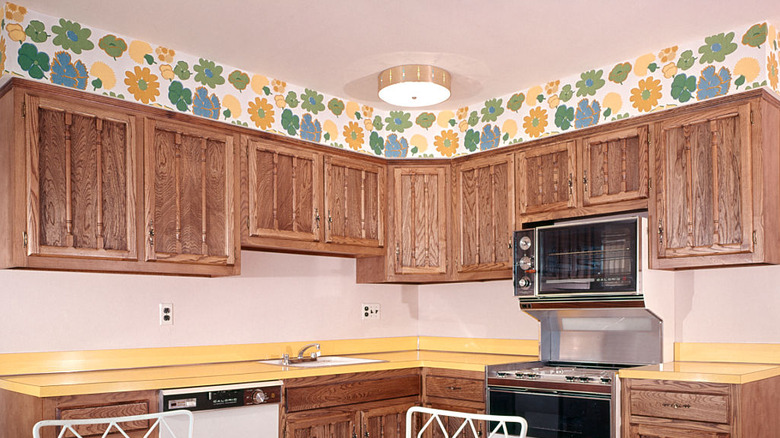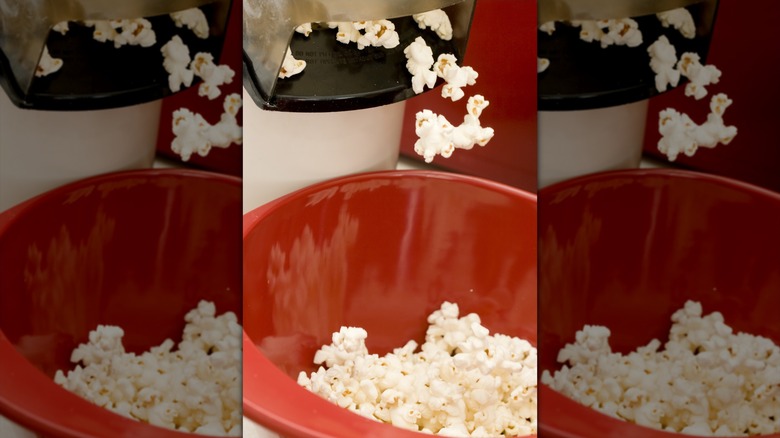13 Things From '70s Kitchens That Totally Vanished
During the 1970s, kitchens were more than a place just to cook and eat, they were warm, inviting rooms where friends and families could gather and socialize, as well. The bright and sunny kitchens of that era were more than just workspaces, since they encouraged conversations as much as they did cooking. Stepping into one of these retro kitchens felt like entering a welcoming space full of contrasting colors and textures. Avocado green, harvest gold, and burnt orange hues ruled the appliance scene, and natural wood touches were everywhere, from butcher blocks to dark-stained cabinetry. Bold, geometric wallpaper and floor tiles were also of-the-moment, and reflected the decade's free-spirited feel.
While some of these natural touches can still be seen in kitchens today, most of the elements that made 1970s homes so groovy have all but disappeared. Cozy breakfast nooks have been replaced with convenient islands, and modern shades of black, white, and gray are favored more than the bright colors of yesteryear. Slip into a pair of bell-bottomed pants and join us for a tour of all of the far-out 1970s kitchen decor, patterns, and appliances that have vanished.
1. Macrame plant hangers
In the 1970s, macrame was found in almost every room of the house, including the kitchen. The crafty knotted rope decor adorned walls in whimsical owl designs and was even transformed into drink coasters, but the most popular way that people displayed their handiwork was as hanging plant holders. The eye-catching holders were sold in plenty of stores, but many people made their own using the two basic macrame knots, the square knot, and the clove hitch, in combination. Thick jute, cotton, or nylon cords were used to make the woven ropes that cradled the plant of choice, and then the holders were suspended on a ceiling hook. In 1970s kitchens, macrame plant holders became iconic symbols of the bohemian flair and handcrafted charm that defined the era.
The plant holders typically featured earthy tones such as rust, olive, and mustard to coordinate with the kitchen furniture and appliances, and were hung in sun-drenched windows or over tables as centerpieces. In addition to basic macrame designs, some homes also displayed more flashy designs showcasing intricate knotting, sparkly beads, and fringe. The pot holders held everything from spider plants to ferns, and blended 1970s hippie aesthetics with a cozy, grounded look. Although you won't find macrame plant holders in many modern kitchens, you may see a few on thrift store shelves.
2. Fondue sets
Nothing says the 1970s more than fondue sets, which were generally found in glazed ceramic or stainless steel. Fondue sets sprang to popularity in the mid-1950s and became commonplace in the 1960s and 1970s, when kitchenware stores sold fondue party kits. The kits consisted of a communal dipping pot and forks that were given to guests so that they could submerge their pieces of food — usually stale bread — into the hot, melty cheese one delicious bite at a time. In 1970s kitchens, the most common types of fondue cheeses included Gruyère, Neufchâtel, and Emmenthal. The quick-melting cheeses were also mixed with white wine, kirsch, or cornstarch to achieve the desired consistency and flavor. In addition to French bread, partygoers dipped a variety of meats and vegetables into the cheese. Fresh fruit was dipped into melted chocolate as a dessert. The cheese and chocolate were kept warm by a candle, Sterno, or alcohol burner placed under the fondue pot.
The hip and fancy fondue parties of the 1970s had roots in Switzerland, and have now become memories of celebrations past. If you want to host a 1970s-themed event in your modern-day kitchen, you can still find fondue pots in stores or online. While crusty French bread still makes the perfect, time-tested companion to the melted cheese, you can also go gourmet with steak tips, roasted Brussels sprouts, shrimp, or fingerling potatoes. You can turn your retro fondue experience into a filling meal rather than just an appetizer.
3. Jell-O molds
The 1970s and elaborate Jell-O molds go hand-in-hand, and everyone's grandma was whipping one up in her kitchen for any given holiday dinner. Although you'd be hard-pressed to find one of these molds in a kitchen cabinet today, they were a staple item in the decade that brought us disco music and the Watergate scandal. Throughout much of the 20th century, Jell-O molds and salads were the shimmering crown jewels of entertaining, and often worked double duty as a table centerpiece and a dessert. The molds were typically made of either metal or brightly colored plastic, and featured shapes such as rings, seashells, and flowers. These whimsical molds transformed the unassuming gelatin of all flavors into culinary sculptures.
The molded Jell-O was often served plain, but sometimes other types of food, including mini marshmallows, canned and fresh fruit, shredded carrots, nuts, and even seafood and cheese, were suspended inside, creating a mosaic of textures and tastes. Even though they don't often — if ever — grace tabletops today, Jell-O molds once celebrated convenience, culinary creativity, and a bit of kitschy elegance.
4. Electric can openers
Electric can openers hit the kitchen scene in 1958, and were status symbols of modern convenience by the 1970s. In 1970, General Electric introduced a model featuring both a can opener and knife sharpener, and it could be found gracing many a kitchen countertop in all of its avocado green or harvest gold splendor. The earthy tones, coupled with the appliance's shiny chrome accents, perfectly matched the decor of that time. Brands like Black & Decker and Sunbeam introduced sleek, space-saving models freeing up precious workspace while adding a futuristic flair. Some electric can openers even mounted under kitchen cabinets for added convenience.
These sometimes bulky gadgets made the daily chore of opening cans a smooth, hands-free experience, and filled the air with a gentle electric whirl, alerting family members that mealtime was near. Canned goods and convenience foods were popular in the 1970s, making electric can openers a busy appliance. Over the years, as kitchens became more streamlined and space was at a premium, smaller, more compact handheld can openers replaced their electric counterparts.
5. Mushroom motif decor
During the 1970s, mushroom motifs sprouted up in American kitchens everywhere, much like fungi after a summer rainstorm. This whimsical and earthy decor trend was most likely inspired by the era's psychedelic movement and fascination of all things nature. Groovy mushroom designs popped up on everything from wallpaper to embroidered kitchen towels, and could also be found brightening up mundane items such as salt and pepper shakers, clocks, and napkin holders. The lively pattern made it easy to create a cohesive themed look throughout the kitchen, and the bright orange, gold, brown, and green hues blended seamlessly with other 1970s decor.
Ceramic kitchen canisters featuring mushroom designs and domed tops added a touch of whimsy to 1970s countertops, while providing convenient storage for sugar, flour, and other baking essentials. Mushroom motifs captured the playful spirit of the 1970s, and were replaced by more neutral colors and patterns in the 1980s. Canisters and different storage solutions became transparent, forcing the spore designs back underground.
6. Electric skillets
Electric skillets were once as popular as air fryers are today, and were used to prepare juicy fried chicken, crispy battered fish, and perfectly done eggs and bacon in the 1970s, among many other tasty treats. Back in the day, electric skillets were seen as the heroes of the countertop, many featuring sleek designs and popular color palettes. The skillets typically featured polished aluminum or stainless steel exteriors in shades of avocado green, almond brown, or rich gold to blend with the rest of the 1970s decor style. Several well-known brands such as West Bend, Presto, Phillips, and Sunbeam offered electric skillets featuring adjustable heat controls and plenty of space for deep frying.
Along with fried items, households also used electric skillets to prepare weekend morning pancakes ( which you only need three ingredients to whip up), and bubbling casseroles, and their design made them ideal for buffet tables. Most skillets had convenient side handles and sturdy lids, making them easy to transport to church potlucks, holiday parties, and other events. Sunbeam also introduced a "super-sized" electric skillet for preparing whole chickens, and turkeys, and other large items.
7. Harvest gold-colored everything
Warm and rich, harvest gold was the golden child of 1970s home decor, and the kitchen was no exception. This caramel-like hue with earthy undertones was found on everything, including large appliances, such as ovens, dishwashers, and refrigerators, as well as wall art, storage containers, and textiles. The buttery hue blended well with the other popular colors of the era, such as avocado green, burnt orange, and deep brown, creating a kitchen space that felt cozy and welcoming. The pastel-colored appliances of the 1950s and vibrant tones of the 1960s were replaced with harvest gold-hued ones, which became symbols of modernity and domestic pride.
Both grounded and boldly expressive, a harvest gold color palette reflected the whimsy of the time, and gave a sun-kissed glow to everyday life. The funky color captured the spirit of the 1970s, along with the other earth tones and nature-inspired motifs. Harvest gold accents also worked in harmony with the decade's popular wood cabinets and wall paneling.
8. Natural decor elements
Earthy accents and design elements took center stage in 1970s kitchens, bringing a bit of the outside in with hanging plants in woven macrame holders, terracotta stoneware, and rustic textiles. Natural materials such as bamboo, rattan, and wood ruled the 1970s furniture scene, and were even found at the kitchen table. Natural tones of moss green, rust, ochre, and sunshine yellow made kitchens feel warm and welcoming, providing a relaxing atmosphere for intimate gatherings and family dinners. Large windows provided the ideal place for suspending plants, giving the kitchen a grounded, terrarium-like feel.
Woodland whimsy, such as mushroom motifs and wood accents, provided 1970s kitchens with the soulful, "lived-in" feel that modern-day rooms seem to lack. The earth-inspired elements of the 1970s lent homes an artisanal charm, as well as plenty of room for personal style expression. Natural tones and accents gave kitchens a comforting, harmonious vibe that worked in unison with the decade's love of hosting.
9. Laminate countertops
Laminate countertops were found in many 1970s kitchens for a variety of reasons. First of all, they offered a lower price point than their natural stone countertops, and were easy to care for and maintain. Smooth laminate countertops were simple to clean and sanitize with just a wipe of the cloth, and were durable, too. Laminate also came in a wide range of colors and designs that worked well with 1970s kitchen decor.
Homeowners could choose to go with one of the signature hues of the era, since laminate was available in avocado green, harvest gold, and orange shades. The colors echoed the earthy palette that defined the decade, and allowed people to embrace their creativity without breaking the bank. Laminate countertops were also available in bold designs such as psychedelic swirls and geometric patterns. Popular brands, including Formica and Wilsonart offered a kaleidoscope of colors and patterns, some mimicking stone and wood grain. Formica's maple butcher block laminate, which has been in production since 1972, blended into the decade's earthy decor scene.
10. Patterned cookware
Bold patterns and vibrant colors were not just limited to wallpaper and appliances in 1970s kitchens. Although a set of avocado green pots and pans, or a casserole dish featuring a mushroom motif may seem kitschy today, they were the epitome of home decor style a few decades ago. Patterned cookware in the 1970s was a vibrant celebration of form meeting function, turning everyday kitchen items into eye-pleasing pieces. While some households had plain-colored cookware, floral patterns bloomed on burnt orange, mustard yellow, and chocolate brown enamel and ceramic surfaces. Geometric patterns were also popular, and enhanced pots and pans, casserole dishes, and serving platters. While these colors and designs were bold, they also reflected the era's earthy design aesthetic.
Patterned cookware from the 1970s wasn't just made to prepare food in, it was also designed to decorate dinner and buffet tables during celebrations and special events. Cooks could uses the decorative kitchen items to showcase their personal home decor style while also serving up perfectly prepared food. Throughout the decade, Corning Glass Works designed a variety of fashionable Pyrex patterns, including the Homestead and Old Orchard lines. If you're lucky, you can still find these collectible pieces, along with vintage patterned cookware from other brands, on thrift store shelves today.
11. Bold wallpaper
Homeowners in the 1970s knew that all of the bold and vibrant fun shouldn't end with their appliances, countertops, and cookware. Why not splash some of those unapologetically loud and exciting design elements on the walls, too? That's right, 1970s kitchens featured wild wallpaper ranging from large floral patterns to intricate, bright geometric designs. Just like other design pieces in the kitchens from the decade, wallpaper was a visual anthem of self-expression and transformed the rooms into warm gathering spaces.
Walls became canvases to showcase vibrantly colored psychedelic swirls, oversized florals, and pop art-inspired patterns. These patterns were anything but shy, and were sometimes accented by metallics. Wallpaper in the 1970s sometimes also featured textured finishes, adding another layer of visual interest. The wallpaper in 1970s kitchens became vibrant backdrops for family gatherings, birthday celebrations, holiday parties, and other special events. Although they're no longer in fashion, the patterned walls of the 1970s infused kitchens with the free-spirited energy the era is known for.
12. Air-pop popcorn poppers
Making popcorn in the 1970s wasn't just a way to whip up a movie night snack, it was an exciting event that the entire family got involved in. This fun ritual was thanks to the invention of hot air popcorn poppers, which exploded in popularity in the late 1970s. Not only did they make tasty popped corn, they also looked sleek and slightly futuristic displayed on kitchen countertops. Hot air poppers emerged as a more health-conscious way to make popcorn, as the traditional stove-top method required the use of a lot of oil. The sleek, groovy poppers used jets of hot air to pop kernels to fluffy perfection.
Popular appliance brands such as Wear-Ever and Presto manufactured the first hot air popcorn poppers, with others following close behind. The allure of these 1970s poppers is that they used no grease and created a minimal mess to produce big bowls of popcorn that families could gather around. Some air popper designs boasted convenient features, including built-in butter wells for an optimal snacking experience. Hot air popcorn poppers may be the only single-use appliance that deserves a comeback in modern-day kitchens.
13. Bread boxes
Old-school bread boxes from the 1970s had two main purposes — to keep the bread fresh while giving kitchens a charming, craftsman appeal. While bread boxes were invented in the early 1900s as a way to keep homemade bread fresher longer, they were still a popular kitchen countertop item in the 1970s. Depending on the type of bread you have, bread boxes may keep your loaf fresher for up to a week longer by limiting mold-producing moisture and keeping pests out. These retro relics weren't exactly boxes, as they featured more of an oval or rectangular shape and opened via hinges, rollers, or a pull-open door.
Just like everything else in 1970s homes, the decade's bread boxes featured colors of avocado green, harvest gold, and burnt orange, and some even had bold floral and geometric patterns. While traditional bread boxes are wood, they were also constructed of plastic, ceramic, and stainless steel. Similar to many other kitchen elements from the time period, bread boxes combined form with function, and were yet another way to express personal decor style. If you happen to get your hands on a vintage bread box, the good news is that not only do they look decorative, but they also keep loaves fresher than plastic bags.
